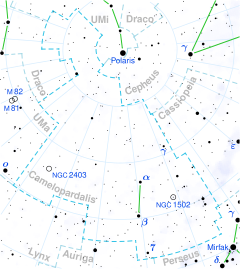| Observation data Epoch J2000.0 Equinox J2000.0 | |
|---|---|
| Constellation | Camelopardalis |
| Right ascension | 04h 59m 46.32836s[1] |
| Declination | +53° 09′ 19.6253″[1] |
| Apparent magnitude (V) | 6.09[2] |
| Characteristics | |
| Evolutionary stage | giant[3] |
| Spectral type | K4 III[4] |
| B−V color index | 1.462±0.009[2] |
| Astrometry | |
| Radial velocity (Rv) | −0.01±0.13[1] km/s |
| Proper motion (μ) | RA: −13.532[1] mas/yr Dec.: −10.700[1] mas/yr |
| Parallax (π) | 4.3709 ± 0.0613 mas[1] |
| Distance | 750 ± 10 ly (229 ± 3 pc) |
| Absolute magnitude (MV) | −0.11[2] |
| Details | |
| Mass | 1.13[5] M☉ |
| Radius | 30.19±3.31[3] R☉ |
| Luminosity | 341±6[1] L☉ |
| Surface gravity (log g) | 2.8[3] cgs |
| Temperature | 4,257+978 −190[1] K |
| Metallicity [Fe/H] | +0.06[3] dex |
| Rotational velocity (v sin i) | 1.6[6] km/s |
| Other designations | |
| Database references | |
| SIMBAD | data |
8 Camelopardalis is a star in the northern circumpolar constellation of Camelopardalis.[7] It is a challenge to view with the naked eye, appearing as a dim, orange-hued star with an apparent visual magnitude of 6.09.[2] Based upon parallax, it is located around 750 light years away from the Sun.[1] At that distance, the visual magnitude is diminished by an extinction of 0.58 due to interstellar dust.[8]
This is an aging K-type giant star with a stellar classification of K4 III,[4] which indicates it has exhausted the hydrogen at its core and evolved away from the main sequence. The star has expanded to 30[3] times the radius of the Sun and is radiating 341[1] times the Sun's luminosity from its enlarged photosphere at an effective temperature of 4,257 K.[1]
References
[edit]- ^ a b c d e f g h i j k Brown, A. G. A.; et al. (Gaia collaboration) (August 2018). "Gaia Data Release 2: Summary of the contents and survey properties". Astronomy & Astrophysics. 616. A1. arXiv:1804.09365. Bibcode:2018A&A...616A...1G. doi:10.1051/0004-6361/201833051. Gaia DR2 record for this source at VizieR.
- ^ a b c d Anderson, E.; Francis, Ch. (2012), "XHIP: An extended hipparcos compilation", Astronomy Letters, 38 (5): 331, arXiv:1108.4971, Bibcode:2012AstL...38..331A, doi:10.1134/S1063773712050015, S2CID 119257644.
- ^ a b c d e Baines, Ellyn K.; et al. (September 2016), "Spectroscopic and Interferometric Measurements of Nine K Giant Stars", The Astronomical Journal, 152 (3): 8, arXiv:1609.02379, Bibcode:2016AJ....152...66B, doi:10.3847/0004-6256/152/3/66, S2CID 52904703, 66.
- ^ a b Appenzeller, Immo (April 1967), "MK Spectral Types for 185 Bright Stars", Publications of the Astronomical Society of the Pacific, 79 (467): 102, Bibcode:1967PASP...79..102A, doi:10.1086/128449.
- ^ Anders, F.; Khalatyan, A.; Chiappini, C.; Queiroz, A. B.; Santiago, B. X.; Jordi, C.; Girardi, L.; Brown, A. G. A.; Matijevič, G.; Monari, G.; Cantat-Gaudin, T.; Weiler, M.; Khan, S.; Miglio, A.; Carrillo, I.; Romero-Gómez, M.; Minchev, I.; De Jong, R. S.; Antoja, T.; Ramos, P.; Steinmetz, M.; Enke, H. (2019), "Photo-astrometric distances, extinctions, and astrophysical parameters for Gaia DR2 stars brighter than G = 18", Astronomy and Astrophysics, 628: A94, arXiv:1904.11302, Bibcode:2019A&A...628A..94A, doi:10.1051/0004-6361/201935765, S2CID 131780028.
- ^ De Medeiros, J. R.; et al. (November 2000), "Rotation and lithium in single giant stars", Astronomy and Astrophysics, 363: 239–243, arXiv:astro-ph/0010273, Bibcode:2000A&A...363..239D.
- ^ a b "8 Cam". SIMBAD. Centre de données astronomiques de Strasbourg. Retrieved 2019-04-15.
- ^ Famaey, B.; et al. (January 2005), "Local kinematics of K and M giants from CORAVEL/Hipparcos/Tycho-2 data. Revisiting the concept of superclusters", Astronomy and Astrophysics, 430 (1): 165–186, arXiv:astro-ph/0409579, Bibcode:2005A&A...430..165F, doi:10.1051/0004-6361:20041272, S2CID 17804304.

Well, that’s interesting to know that Psilotum nudum are known as whisk ferns. Psilotum nudum is the commoner species of the two. While the P. flaccidum is a rare species and is found in the tropical islands. Both the species are usually epiphytic in habit and grow upon tree ferns. These species may also be terrestrial and grow in humus or in the crevices of the rocks.
View the detailed Guide of Psilotum nudum: Detailed Study Of Psilotum Nudum (Whisk Fern), Classification, Anatomy, Reproduction